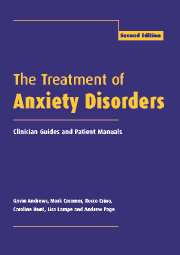Book contents
- Frontmatter
- Contents
- List of authors
- Preface to the second edition
- Abbreviations
- 1 Read me
- 2 General issues in anxiety disorders
- 3 General issues in treatment: Clinician Guide
- 4 Panic disorder and agoraphobia: Syndrome
- 5 Panic disorder and agoraphobia: Treatment
- 6 Panic disorder and agoraphobia: Clinician Guide
- 7 Panic disorder and agoraphobia: Patient Treatment Manual
- 8 Social phobia: Syndrome
- 9 Social phobia: Treatment
- 10 Social phobia: Clinician Guide
- 11 Social phobia: Patient Treatment Manual
- 12 Specific phobias: Syndrome
- 13 Specific phobias: Treatment
- 14 Specific phobias: Clinician Guide
- 15 Specific phobias: Patient Treatment Manual
- 16 Obsessive-compulsive disorder: Syndrome
- 17 Obsessive-compulsive disorder: Treatment
- 18 Obsessive-compulsive disorder: Clinician Guide
- 19 Obsessive-compulsive disorder: Patient Treatment Manual
- 20 Generalized anxiety disorder: Syndrome
- 21 Generalized anxiety disorder: Treatment
- 22 Generalized anxiety disorder: Clinician Guide
- 23 Generalized anxiety disorder: Patient Treatment Manual
- 24 Posttraumatic stress disorder: Syndrome
- 25 Posttraumatic stress disorder: Treatment
- 26 Posttraumatic stress disorder: Clinician Guide
- 27 Posttraumatic stress disorder: Patient Treatment Manual
- 28 Conclusions
- References
- Index
5 - Panic disorder and agoraphobia: Treatment
Published online by Cambridge University Press: 05 August 2016
- Frontmatter
- Contents
- List of authors
- Preface to the second edition
- Abbreviations
- 1 Read me
- 2 General issues in anxiety disorders
- 3 General issues in treatment: Clinician Guide
- 4 Panic disorder and agoraphobia: Syndrome
- 5 Panic disorder and agoraphobia: Treatment
- 6 Panic disorder and agoraphobia: Clinician Guide
- 7 Panic disorder and agoraphobia: Patient Treatment Manual
- 8 Social phobia: Syndrome
- 9 Social phobia: Treatment
- 10 Social phobia: Clinician Guide
- 11 Social phobia: Patient Treatment Manual
- 12 Specific phobias: Syndrome
- 13 Specific phobias: Treatment
- 14 Specific phobias: Clinician Guide
- 15 Specific phobias: Patient Treatment Manual
- 16 Obsessive-compulsive disorder: Syndrome
- 17 Obsessive-compulsive disorder: Treatment
- 18 Obsessive-compulsive disorder: Clinician Guide
- 19 Obsessive-compulsive disorder: Patient Treatment Manual
- 20 Generalized anxiety disorder: Syndrome
- 21 Generalized anxiety disorder: Treatment
- 22 Generalized anxiety disorder: Clinician Guide
- 23 Generalized anxiety disorder: Patient Treatment Manual
- 24 Posttraumatic stress disorder: Syndrome
- 25 Posttraumatic stress disorder: Treatment
- 26 Posttraumatic stress disorder: Clinician Guide
- 27 Posttraumatic stress disorder: Patient Treatment Manual
- 28 Conclusions
- References
- Index
Summary
In 1988, Barlow examined the evidence from around the world and concluded that “with specifically targeted psychological treatments, panic is eliminated in close to 100% of all cases, and these results are maintained at follow-ups of over 1 year. If these results are confirmed by additional research and replication, it will be one of the most important and exciting developments in the history of psychotherapy” (Barlow, 1988;p. 447). The question facing researchers and clinicians alike is, with the benefit of more than a decade of subsequent research and replication, “Is it possible to concur with Barlow's statement?”. The place to begin this evaluation is by addressing the criteria of effective treatment for panic disorder and agoraphobia.
Aims of treatment
Panic disorder and agoraphobia are currently conceptualized as two separate, but frequently related, disorders. Specifically, panic attacks are considered the “motor” that “drives” the agoraphobic avoidance (e.g., Clarke and Jackson, 1983). Therefore, it would be expected that effective long-term treatment for agoraphobia would require effective long-term management of panic attacks. By extension, the first aim of an effective treatment for agoraphobia (with panic disorder) would be to stop panic attacks and their interference in an individual's life. The second aim would be to reduce any concurrent agoraphobic avoidance. Just as with the specific phobias, avoidance will involve anticipatory anxiety and anxiety triggered upon exposure and treatment will be more than simply “turning off” avoidance. However, an ideal treatment would do more than modify the existing symptoms; it would reduce the vulnerability to the disorder. If the vulnerability to panic disorder and agoraphobia (e.g., trait anxiety) could be modified, relapse would presumably be decreased. In summary, effective treatment of panic disorder and agoraphobia will involve (1) the control of panic attacks, (2) the cessation of fear-driven avoidance, and (3) reduction of the vulnerability.
Nondrug treatments
Exposure
In vivo exposure has been one of the strongest and most consistently demonstrated treatments for agoraphobic avoidance. In fact, it has often been demonstrated to be superior to placebo interventions as well as other credible psychological treatments (e.g., Mathews et al., 1981;Mavissakalian and Barlow, 1981; Emmelkamp, 1982;Teusch and Boehme, 1999) - a none too easy achievement in psychological research. Furthermore, when anti-exposure instructions are included in comparison therapies, the strength of exposure becomes even more evident (e.g., Greist et al., 1980;Telch et al., 1985).
- Type
- Chapter
- Information
- The Treatment of Anxiety DisordersClinician Guides and Patient Manuals, pp. 54 - 64Publisher: Cambridge University PressPrint publication year: 2002



